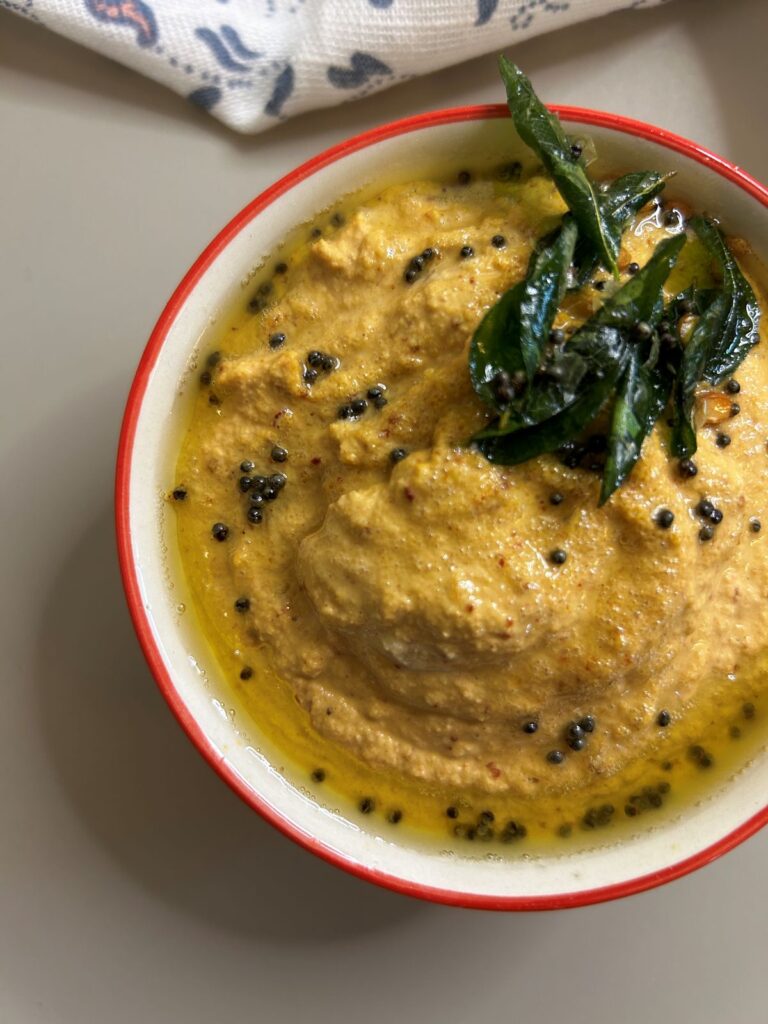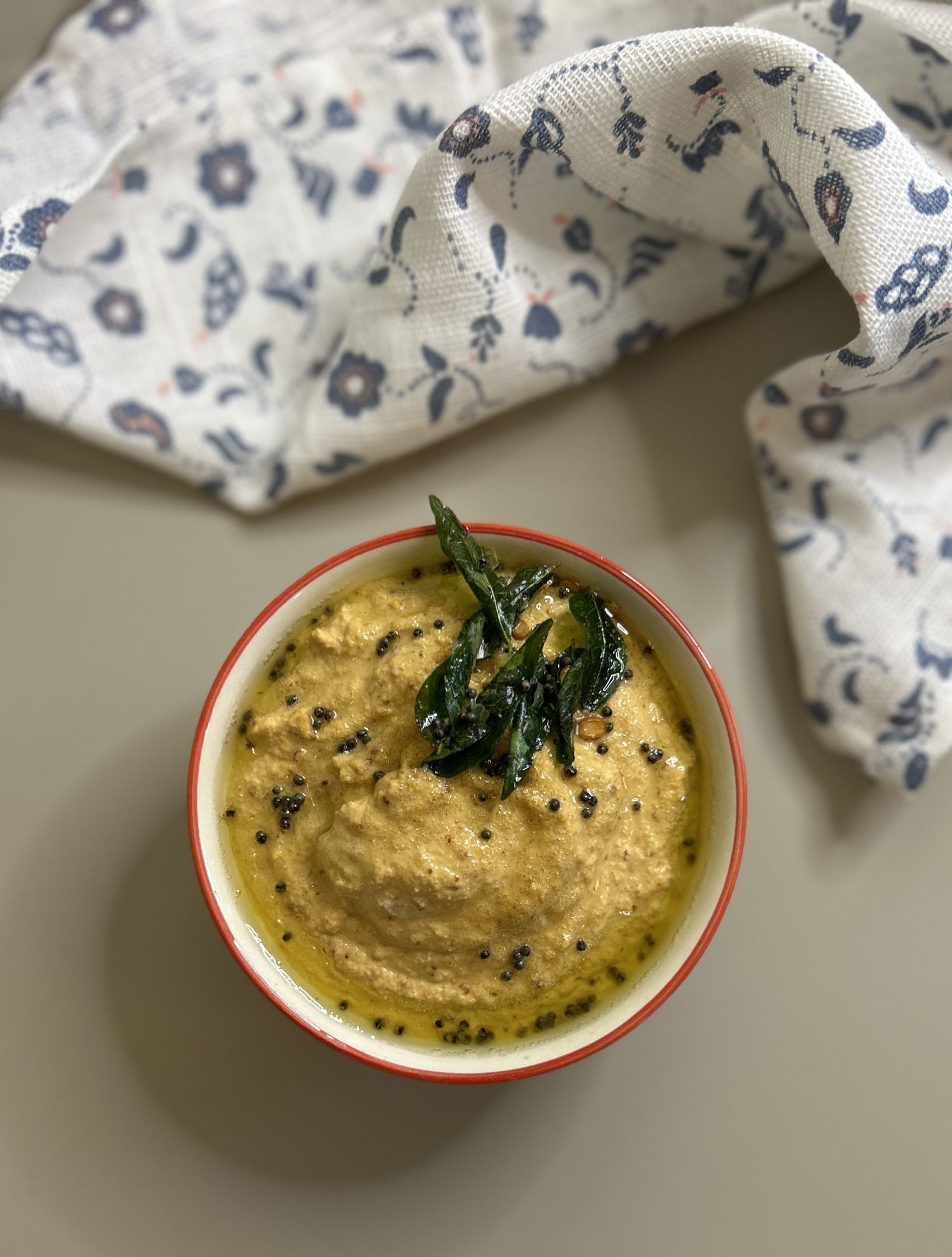A nutty, sour and spicy chutney, this peanut chutney will make a fantastic pairing with dosa, idli and shavige!
Table of Contents
Peanut Chutney
Peanut Chutney is a favourite chutney of mine with peanuts as the hero ingredient. The chutney has flavours of spice from the red chillies, sourness from the tamarind extract and a subtle sweetness from the peanuts itself.
I make this chutney often since it goes well with all tiffin dishes, either be it for breakfast or for office dabba.
This condiment pairs well with dosa, idli, and I specifically love it with Shavige as it compliments well with it.

Chutneys have always been popular in Indian cuisine, but peanut chutney would’ve made its appearance much later since the Portuguese introduced peanuts to Indians in the 16th century. Peanuts have their origin in South America, much like several ingredients that we use in day-to-day food.
Peanuts gained its popularity in South India more than the North, since the Portuguese presence was primarily on the coasts of Southern India. It is popular since it is terribly easy to make and accessible to everyone. It has high nutritional value and provides satiety when consumed with dosa or idli.
Ingredients for the Chutney
I use roughly 100-150g of peanuts for my family of 3, but you can increase it up to 200-250g. Once you grind the chutney, the quantity does tend to increase.
For any chutney, there should be some sort of souring agent. In this recipe, we are going to use tamarind extract. Take a one rupee coin sized quantity of tamarind and soak it in some warm water. Once it has dissolved for a bit (2-3 minutes), you can rub the tamarind in between your fingers to extract the pulp. At this stage, you can remove the fibres and seeds if any.
A chutney is nothing without its spice – I love to use dried red chillies for chutneys and in this case I am using 2-3 dried Byadagi red chillies, that render a mildly spicy flavour along with the beautiful red colour.
Garlic is an optional ingredient but I must tell you that it really adds to the flavour. I add garlic to this chutney when I know the chutney will finish in one sitting and will not be making a stop in the fridge.
The other ingredients you need are for the tempering/ seasoning part – you will need gingelly oil, mustard seeds, split urad dal, asafoetida powder and curry leaves.
How to make the peanut chutney?
The process is fairly simple. The groundnuts need to be toasted first. This will aid in enhancing the flavour texture and intensifies their natural oils and brings about a nuttier flavour. It also helps in removing any moisture, if it’s there. If you plan on removing the skin of the peanuts, toasting will assist in this process.
Place a pan on medium heat. Add the peanuts and toast it until the skin has a slightly darker colour. You might also observe the skin peeling off and the groundnut splitting into halves. This process will take about 2-3 minutes. Transfer the peanuts to a plate and allow it to cool down before you can de-skin them. (I usually don’t remove the skin, but you can if you have the time)
Meanwhile, you can soak a small piece of tamarind in warm water. After a few minutes, rub the tamarind between your fingers to extract the pulp. Remove any fibre and seeds if any. You may also use store-bought tamarind extract but added less than half a teaspoon of it – they tend to be quite concentrated.
Use the same pan and dry roast the red chillies and garlic on a low flame. Toss them around on the pan for roughly 2-3 minutes until you can see that the red chillies have crisped up. Turn off the flame and add it to the same plate as the peanuts.
Once all the ingredients are cool, add the peanuts, red chillies, garlic and tamarind extract to the mixer and grind it to a smooth paste. Transfer the peanut chutney to a bowl and add 1/2 tsp of salt. Adjust it according to your taste. If you want to, at this stage, add a little water to achieve the desired consistency.
Tempering the Peanut Chutney
The last step of making this chutney is to temper/season it.
Place a tadka pan on a low-medium heat and add cooking oil. I use gingelly oil. Once the oil is warm, add the mustard seeds and allow it to sputter. Next, add the split urad dal, asafoetida powder and curry leaves to it. Turn off the flame.
Add this tadka mixture to the peanut chutney and mix well.
Serve your Peanut Chutney with a dosa of your choice. They go well with idlis and shavige too.
Storage and Shelf Life
Peanut Chutney is best eaten fresh. If you add garlic to the chutney, I suggest not to keep it in the fridge at all. I suggest eating all chutneys fresh and finishing them within the mealtime they were made for.
If you do have leftovers, you can keep it in the fridge, but finish it off the next day.
It’ll be great if you tag me on Instagram @ Make Potato when you make this recipe
Please do leave a rating and a comment if you can, on the recipe below – it will help me grow and reach more food lovers like you.
Recipe
Peanut Chutney
Ingredients
- 1 cup Peanuts (150-180g)
- Tamarind coin sized
- 3-4 Dried Red Chillies Byadagi/Kashmiri
- 2-3 cloves Garlic optional
For the tempering
- 1 tsp Cooking oil (I prefer gingelly oil)
- ½ tsp Mustard Seeds
- ½ tsp Split Urad Dal
- ½ tsp Asafoetida Powder
- 2 sprig Curry Leaves
Instructions
- The first step is to roast the peanuts on a low flame. Place a pan on low-medium flame. Once the pan is warm, add the peanuts to it. Roast the peanuts until you hear the crackle of the peanuts splitting and you can notice that the skin is about to come off.
- At this stage, turn off the flame and transfer the peanuts to a plate for them to cool down. I usually do not remove the skin but if you want to you can remove the skin at this stage by rubbing the peanuts between your fingers to remove it.
- While the peanuts are cooling down, you can soak the tamarind in bowl of warm water. Allow it to soak for a few minutes. Using your fingers, extract the pulp from the tamarind and remove the fibres and seeds if there are any.
- In the same pan, roast the dried red chillies for a couple of minutes without the stalk. Once the red chillies are crisp, (should take less than 2 minutes) turn off the heat and allow it to cool down. If you are using garlic, roast the garlic for a couple of minutes along with the red chillies too.
- To a mixer jar, add the cooled peanuts, tamarind extract along with the water and the red chillies (and garlic). Grind it to a smooth paste. Transfer the chutney to a container. Add 1/2 tsp salt and adjust it according to your taste. The next step is to season/temper the chutney.
Tempering the chutney
- Place a tadka pan on a low-medium flame. Add a teaspoon of oil to it.
- Once the oil is warm, add the mustard seeds and split urad dal. Alow the mustard seeds to crackle.
- When the crackling stops, add the asafoetida powder and curry leaves. Turn off the flame.
- Add this tempering to the bowl of peanut chutney.
- Mix well and your Peanut chutney is ready!
If you are looking for more Chutney and Pickle Recipes, please click here.
Do follow me on Instagram at Make Potato — I post daily lunch box ideas and quick snack recipes.






